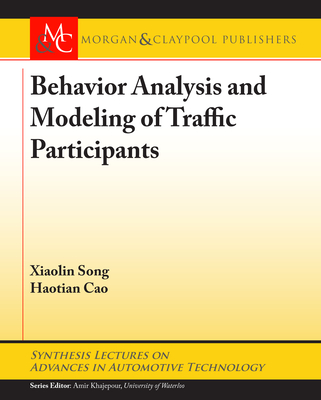Behavior Analysis and Modeling of Traffic Participants
暫譯: 交通參與者的行為分析與建模
Song, Xiaolin, Cao, Haotian
- 出版商: Morgan & Claypool
- 出版日期: 2021-12-01
- 售價: $2,440
- 貴賓價: 9.5 折 $2,318
- 語言: 英文
- 頁數: 172
- 裝訂: Quality Paper - also called trade paper
- ISBN: 1636392628
- ISBN-13: 9781636392622
-
相關分類:
自駕車
海外代購書籍(需單獨結帳)
相關主題
商品描述
A road traffic participant is a person who directly participates in road traffic, such as vehicle drivers, passengers, pedestrians, or cyclists, however, traffic accidents cause numerous property losses, bodily injuries, and even deaths to them</b>. To bring down the rate of traffic fatalities, the development of the intelligent vehicle is a much-valued technology nowadays. It is of great significance to the decision making and planning of a vehicle if the pedestrians' intentions and future trajectories, as well as those of surrounding vehicles, could be predicted, all in an effort to increase driving safety. Based on the image sequence collected by onboard monocular cameras, we use the Long Short-Term Memory (LSTM) based network with an enhanced attention mechanism to realize the intention and trajectory prediction of pedestrians and surrounding vehicles.</p><p>However, although the fully automatic driving era still seems far away, human drivers are still a crucial part of the road?driver?vehicle system under current circumstances, even dealing with low levels of automatic driving vehicles. Considering that more than 90 percent of fatal traffic accidents were caused by human errors, thus it is meaningful to recognize the secondary task while driving, as well as the driving style recognition, to develop a more personalized advanced driver assistance system (ADAS) or intelligent vehicle. We use the graph convolutional networks for spatial feature reasoning and the LSTM networks with the attention mechanism for temporal motion feature learning within the image sequence to realize the driving secondary-task recognition.</p><p>Moreover, aggressive drivers are more likely to be involved in traffic accidents, and the driving risk level of drivers could be affected by many potential factors, such as demographics and personality traits. Thus, we will focus on the driving style classification for the longitudinal car-following scenario. Also, based on the Structural Equation Model (SEM) and Strategic Highway Research Program 2 (SHRP 2) naturalistic driving database, the relationships among drivers' demographic characteristics, sensation seeking, risk perception, and risky driving behaviors are fully discussed. Results and conclusions from this short book are expected to offer potential guidance and benefits for promoting the development of intelligent vehicle technology and driving safety.
商品描述(中文翻譯)
道路交通參與者是指直接參與道路交通的人,例如車輛駕駛員、乘客、行人或騎自行車的人。然而,交通事故對他們造成了大量的財產損失、身體傷害,甚至死亡。為了降低交通死亡率,智能車輛的發展如今被視為一項重要技術。如果能夠預測行人的意圖和未來軌跡,以及周圍車輛的行為,對於車輛的決策和規劃將具有重大意義,這一切都是為了提高駕駛安全性。我們基於車載單目相機收集的影像序列,使用基於長短期記憶(Long Short-Term Memory, LSTM)的網絡,結合增強的注意力機制,實現行人和周圍車輛的意圖及軌跡預測。
然而,儘管完全自動駕駛的時代似乎仍然遙不可及,但在當前情況下,人類駕駛員仍然是道路-駕駛員-車輛系統中至關重要的一部分,即使是在處理低自動駕駛車輛的情況下。考慮到超過90%的致命交通事故是由人為錯誤造成的,因此識別駕駛過程中的次要任務以及駕駛風格識別,對於開發更具個性化的先進駕駛輔助系統(ADAS)或智能車輛是有意義的。我們使用圖卷積網絡進行空間特徵推理,並使用帶有注意力機制的LSTM網絡進行影像序列中的時間運動特徵學習,以實現駕駛次要任務的識別。
此外,激進的駕駛者更容易捲入交通事故,駕駛者的駕駛風險水平可能受到許多潛在因素的影響,例如人口統計特徵和個性特徵。因此,我們將專注於縱向跟車場景中的駕駛風格分類。同時,基於結構方程模型(Structural Equation Model, SEM)和戰略高速公路研究計劃2(Strategic Highway Research Program 2, SHRP 2)自然駕駛數據庫,全面討論駕駛者的人口特徵、尋求刺激、風險感知和危險駕駛行為之間的關係。本書的結果和結論預期將為促進智能車輛技術和駕駛安全的發展提供潛在的指導和益處。











